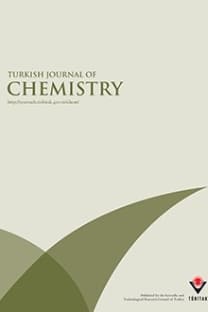Metal Complexes of Schiff Bases: Preparation, Characterization, and Biological Activity
2-thiophenecarboxaldehyde, 2-furancarboxaldehyde, 2-aminothiophenol, o-phenylenediamine, transition metal complexes, stability constants, IR, 1H NMR, conductance, solid reflectance, magnetic moment, thermal analysis, biological activity
Metal Complexes of Schiff Bases: Preparation, Characterization, and Biological Activity
2-thiophenecarboxaldehyde, 2-furancarboxaldehyde, 2-aminothiophenol, o-phenylenediamine, transition metal complexes, stability constants, IR, 1H NMR, conductance, solid reflectance, magnetic moment, thermal analysis, biological activity,
___
- R.D. Jones, D.A. Summerville and F. Basolo, Chem. Rev. 79, 139 (1979).
- G.H. Olie and S. Olive, “The Chemistry of the Catalyzes Hydrogenation of Carbon Monoxide”, p.
- , Springer, Berlin, 1984.
- H. Dugas and C. Penney, “Bioorganic Chemistry”, p. 435, Springer, New York, 1981.
- J.D. Margerum and L.J. Mller, “Photochromism”, p. 569, Wiley Interscience, New York, 1971.
- W.J. Sawodny and M. Riederer, Angew. Chem. Int. Edn. Engl. 16, 859 (1977).
- A.S. Salameh and H.A. Tayim, Polyhedron, 2, 829-34 (1983).
- H.A. Tayim and A.S. Salameh, Polyhedron, 2, 1091-4 (1983).
- B.T. Thaker, Proc. Natl. Acad. Sci. India, Sect. A, 58, 443-7 (1988).
- S.D. Kolwalkar and B.H. Mehta, Asian J. Chem. 8, 406-410 (1996).
- M.A. Khalifa and A.M. Hassaan, J. Chem. Soc. Pak. 18, 115-118 (1996).
- Y.M. Issa, M.M. Omar, H.M. Abdel-Fattah and A.A. Soliman, J. Indian Chem. Soc. 73, (1996).
- J.J. Murthy and B.H. Mehta, Orient. J. Chem. 14, 129-131 (1998).
- S. Zhou, S. Liu and G. Zhou, Huaxue Shiji, 23, 26-27 (2001).
- N. Raman, A. Kulandaisamy and K. Jeyasubramanian, Synth. React. Inorg. Met.-Org. Chem. 31, 1249- 1270 (2001).
- S. Zhou, F. Xie and S. Ni, Huaxue Shiji, 23, 261-262 (2001).
- A.I. Vogel, ”Practical Organic Chemistry Including Quantitative Organic Analysis”, 3rdEd., p. 854, Longmans; London, 1956.
- A.I. Vogel, “Quantitative Inorganic Analysis Including Elemental Instrumental Analysis”, 2ndEd., Longmans; London, 1962.
- R. Sarin and K.N. Mushi, J. Inorg. Nucl. Chem. 34, 581 (1972).
- D. Feng and B. Wang, Transition Met. Chem. 18, 101-3 (1993). M. Kumar, Asian J. Chem. 6, 576-80
- F. Capitan, P. Espinosa, F. Molina and L.F. Capitan-Vallvey, Rev. Roum. Chim. 32, 151-4 (1987).
- H.A. Tayim and A.S.S. Salameh, Polyhedron, 2, 10, 1091-4 (1983).
- M.E. Ibrahim, A.A.H. Ali and F.M.M. Maher, J. Chem. Techn. Biotechnol. 55, 217 (1992).
- N. Sari, S. Arslan, E. Logoglu and I. Sakiyan, J. of Sci. 16, 283 (2003).
- J. Bjerrum, “Metal Amine Formation in Aqueous Solution”, Haase, Copenhagen, 1941.
- H. Irving and R.J.P. Williams, Nature, 162, 746 (1948).
- H. Irving and R.J.P. Williams, J. Chem. Soc. 3192 (1953).
- R.D. Jones, D.A. Summerville and F. Basolo, Chem. Rev. 79, 139 (1979).
- L.E. Orgel, “An Introduction to Transition Metal Chemistry Ligand Field Theory”, p.55, Methuen, 1966.
- G.G. Mohamed, Zeinb H.Abd El.Wahwb, J. Thermal Anal. 73, 347-359 (2003).
- A.A. Soliman and W. Linert, Thermochimica Acta, 333, 67-75 (1999).
- A.P. Mishra, J. Indian Chem. Soc. 76, 35-37 (1999).
- A. Kriza, M. Voiculescu and A. Nicolae, Analele Universitatii Bucuresti. Chimie, 11, 197- 201 (2002).
- J.K. Nag, D. Das, B.B. De and C. Sinha, J. Indian Chem. Soc. 75, 496-498 (1998).
- M. Hossain, S.K. Chattopadhyay and S. Ghosh, Polyhedron, 16, 1793-1802 (1997).
- M.M. Moustafa, J. Thermal Anal. 50, 463-471 (1997).
- G.G. Mohamed, Nadia E.A. El-Gamel and F.A. Nour El-Dien, Synth. React. Inorg. Met.- Org. Chem. 31,347-358 (2001).
- F.A. Cotton, G. Wilkinson, C.A. Murillo and M. Bochmann, “Advanced Inorganic Chemistry”, 6thed., Wiley, New York, 1999.
- D.R. Zhu, Y. Song, Y. Xu, Y. Zhang, S.S.S. Raj, H.K. Fun and X.Z. You, Polyhedron, 19, 2019- 2025 (2000).
- R. Prasad, P.P. Thankachan, M.T. Thomas and R. Pathak, J. Ind. Chem. Soc. 78, 28-31 (2001).
- M.S. Masoud, A.M. Hindawy and A.S. Soayed, Trans. Met. Chem. 16, 372-376 (1991).
- N.K. Gaur, R. Sharma and R.S. Sindhu, J. Ind. Chem. Soc. 78, 26-27 (2001).
- M.M. Omar and Gehad G. Mohamed, Spectrochimica Acta, Part A, 61, 929-936 (2005).
- N. Mondal, D.K. Dey, S. Mitra and K.M. Abdul Malik, Polyhedron, 19, 2707-2711 (2000).
- J. Kohout, M. Hvastijova, J. Kozisek, J.G. Diaz, M. Valko, L. Jager and I. Svoboda, Inorg Chim. Acta 287, 186-192 (1999).
- A. Bury, A.E. Underhill, D.R. Kemp, N.J. O’Shea, J.P. Smith, P.S. Gomm and F. Hallway, Inorg. Chim. Acta, 138, 85-89 (1987).
- N.R.S. Kumar, M. Nethiji and K.C. Patil, Polyhedron, 10, 365-371 (1991).
- J. Manonmani, R. Thirumurugan, M. Kandaswamy, M. Kuppayee, S.S.S. Raj, M.N. Ponnuswamy, G. Shan- mugam and H.K. Fun, Polyhedron, 19, 2011-2018 (2000).
- J. Sanmartin, M.R. Bermejo, A.M.G. Deibe, M. Maneiro, C. Lage and A.J.C. Filho, Polyhedron, 19, 185-192
- V.P. Krzyminiewska, H. Litkowska and W.R. Paryzek, Monatshefte Fur Chemie, 130, 243-247 (1999).
- K.Bertoncello, G.D. Fallon, K.S. Murray and E.R.T. Tiekink, Inorg. Chem. 30, 3562 (1991).
- A.W. Coats and J.P. Redfern, Nature, 20, 68 (1964).
- D.C. Shanson, “Microbiology in Clinical Practice”, Wright PSG, Bristol, London, Boston, 1982.
- E. Jawetz, J.L. Melnick and E.A. Adelberg, “Review of Medical Microbiology”, Lang Medical Publications, Los Angeles, California, 16thed., 1979.
- A.M.S. El-Sharief, M.S. Ammar, Y.A. Ammar and M.E. Zak, Ind. J. Chem. 22B, 700-704 (1983).
- A.M.S. El-Sharief, M.S. Ammar and Y.A. Mohammed, Egypt. J. Chem. 27, 535-546 (1984).
- ISSN: 1300-0527
- Yayın Aralığı: 6
- Yayıncı: TÜBİTAK
Turgay SEÇKİN, Ergun EKİNCİ, Süleyman KÖYTEPE, Aziz PAŞAHAN
Ergun EKİNCİ, Süleyman KÖYTEPE, Aziz PAŞAHAN, Turgay SEÇKİN
Çakıl ERK, Matthias HEYDENREICH, And Erich KLEINPETER
Metal Complexes of Schiff Bases: Preparation, Characterization, and Biological Activity
Gehad Geindy MOHAMED, Mohamed Mohamed OMAR, Ahmed Mohamed HINDY
Muhammad Kaleem KHOSA, Muhammad MAZHAR, Saqib ALI
Online Viscosity Measurement of Complex Solutions Using Ultrasound Doppler Velocimetry
Volkan KÖSELİ, Şerife ZEYBEK, Yusuf ULUDAG
Murat AKARSU, Meltem ASİLTÜRK, Funda SAYILKAN
Cumene Cracking on Modified Mesoporous Material Type MCM-41
Ahmed BELHAKEM and Abdelkader BENGUEDDACH
Iridoid, flavonoid, and phenylethanoid glycosides form Wiedemannia orientalis
Cavit KAZAZ, Hilal ÖZBEK, Zühal GÜVENALP, L. Ömür DEMİREZER, Türesin ÜNSALAR
